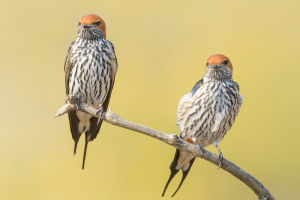The Lesser Striped Swallow (Cecropis abyssinica) is a captivating bird found throughout sub-Saharan Africa, admired for its striking appearance, skillful flight, and fascinating nesting habits.
As an integral part of Africa’s diverse ecosystems, this swallow adds a splash of color and energy to the landscape, attracting birdwatchers and nature lovers from around the world.
Distinctive Physical Traits
This swallow species is known for its vibrant plumage and sleek, streamlined body, perfect for agile flight. The back feathers shimmer with a glossy, iridescent blue that contrasts beautifully with the deep chestnut-orange of the head and throat. Their underparts are a creamy white, accented with bold dark stripes, giving the bird its “striped” name.
Widespread Habitat and Range
Lesser Striped Swallows have adapted well to various environments across sub-Saharan Africa. They thrive in open woodlands, savannas, and grasslands but are also commonly found near water bodies like rivers and lakes, where insect populations are plentiful. Remarkably adaptable, these birds are often seen near human settlements, making use of modern structures like bridges, homes, and barns for nesting. This close interaction with human habitats highlights their resilience and adaptability in the face of changing environments.
Intricate Nesting Habits
One of the most fascinating aspects of the Lesser Striped Swallow is its remarkable nest-building ability. These birds construct gourd-shaped nests made of mud pellets, painstakingly collected and formed using their beaks. The nests are often secured to vertical surfaces like cliffs, bridges, or the eaves of houses, providing protection from predators and harsh weather conditions.
Social Behavior and Community Living
Lesser Striped Swallows are social birds, frequently seen in pairs or small colonies. They are known for their cooperative behavior, often working together to defend their nests and feeding grounds from threats. During the breeding season, the swallows are particularly vigilant, displaying incredible teamwork to ensure the safety of their young.
Diet and Feeding Strategy
As insectivores, Lesser Striped Swallows have a diet that consists mainly of flying insects such as flies, beetles, and moths. They are expert hunters, catching their prey mid-air with precision and grace. Their aerial acrobatics are not only mesmerizing to watch but also essential for maintaining the ecological balance by controlling insect populations.
Conservation Status and Environmental Impact
Fortunately, the Lesser Striped Swallow is currently listed as “Least Concern” by the International Union for Conservation of Nature (IUCN). Despite this stable status, the bird still faces threats from habitat destruction and environmental degradation. Rapid urbanization, deforestation, and climate change all pose risks to their natural habitats.
The Lesser Striped Swallow is more than just a beautiful bird; it is a symbol of adaptability, resilience, and the intricate balance of nature. So, Lykkers, with their stunning plumage, exceptional flight abilities, and impressive nest-building skills, these swallows are a delight to observe.


